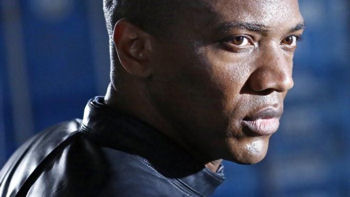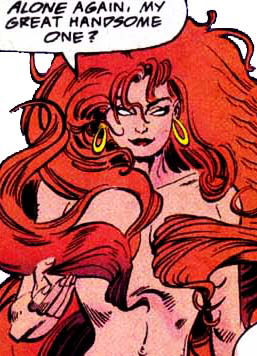Deathlok Comes To S.H.I.E.L.D.--
Why Do We Care, And What Should We Care About?
Yes, we called this on our podcast two weeks ago, as did probably every comics fan still watching Marvel's Agents of S.H.I.E.L.D. on ABC. Mike Peterson (J. August Richards) had apparently been killed in an explosion, only to awaken at the end of an episode with a cybernetic eye implant, a missing leg, and a whole lot of scarring.
While not a character previously linked to any Marvel Comics' appearances, Peterson's injuries seemed consistent with those requiring replacement and the appearance of a long-time Marvel character with multiple identities -- Deathlok.
Yesterday at a Television Critics' Association panel, head of Marvel TV Jeph Loeb confirmed that Peterson would be going through "some changes," and ultimately become Deathlok, which, let's be clear, is considered both a character and a technology in the Marvel Universe.
That comes on the heels of last week's announcement that Sif (Jamie Alexander) from Thor and Thor: The Dark World would be appearing on the show, in search of another escaped Asgardian, the seductive Lorelei. Oh, yeah, and Stan Lee, who may rapidly becoming as fictional as his creations, will appear on the show, too.
So what's with all the excitement? Arrow has been bringing DC characters to television for a couple of years and nobody's quite as excited. It may be because their versions are so "real world," while Marvel's heroes are actually fairly close in execution to who they are in the comics -- which is, after all, where they started and why we're watching in the first place.
| |
| J. August Richards, movie star? |
Somehow, too, we are more invested because if Sif can come to television, Deathlok can join other heroes on the big screen. It's all one big super story if we want it.
As good as Arrow is, and hopefully will be echoed by The Flash on CW, that's where it stays. And movie versions of those characters are going to be completely different -- maybe closer to the comics, maybe horribly wrong. (Despite my iniital misgivings, I think Stephen Amell's Oliver Queen feels pretty true to Green Arrow, though again, it took a long time for the series to not be ashamed of it being about a superhero.)
But in all this excitement, let us take a moment to acknowledge the comics origins of all three of these characters, and wonder in a week of Comic Book Babylon if the right people are getting attention.
Well, first, J. August Richards, good for you! I knew when he appeared in the pilot that the very loyal Joss Whedon would do right by an actor who had done right by him on Angel. So, so pleased that he has turned out to not be a throwaway character. Instead, a good actor is getting a high profile. I love it.
But as often happens with this kind of media shift, the guys that had the idea for the characters are getting lost.
Although many people are hearing the name "Deathlok" for the first time, the character has been around, in one form or another, since 1974. Admittedly, more "cool" than "popular" in Marvel's stable of characters, he was part of the deal fifteen years ago for Artisan to develop Marvel movies, and somewhere in Paramount's stable of "what if" screenplays, there's one for Deathlok from around 2007. So when Loeb says this has been the plan for Mike Peterson all along, chances are he's telling the absolute truth.
1974's Deathlok (aka "The Demolisher") first appeared in Astonishing Tales #25, created by writer Doug Moench and artist Rich Buckler, two names we should remember because to the mainstream, they're not giants of the industry, but their work was solid and influential.
Originally separate from the Marvel Universe, soldier Luther Manning awoke in the then-future 1990 to find himself an animated corpse controlled by a computer (which he calls "puter"). Through time-travel, he did team up with Spider-Man and The Thing (both characters he currently canNOT team up with in the Marvel Cinematic Universe).
Deathlok made his most memorable appearance in a four-issue run-in with Captain America, where he returned to his alternate future and realized that as torn, battered, and inhuman as he might seem to be, Luther Manning was the Captain America of his time, if not working to restore the U.S., at least offering hope to its citizens.
Long after Moench and Buckler left Marvel, writers went wild with the concept, and a variety of subsequent Deathloks have appeared in the comics. So it's not so wild that a heretofore unknown character should become Deathlok.
But it still comes back to Moench and Buckler, and we have hopes that at the very least, in the credits of Marvel's Agents of S.H.I.E.L.D., we should see them acknowledged as they do people like Jack Kirby and Jim Steranko. A little money would probably be nice, but unfortunately Moench and Buckler created Deathlok in 1974, a hazy time period that has not legally been good to creators seeking acknowledgment in the present. But we can hope.
| |
| We'll have to see what her, um, costume looks like on TV... |
As for the Thor characters, well, Lady Sif was there almost from the beginning, and Stan Lee and Jack Kirby at least get credit for that. As the movies acknowledge that many hands brought Thor to where he is today, we should point out that Lorelei is a creation from writer/artist Walt Simonson's run, and because this happened in 1982, chances are that he is being treated a little better. At least, more people know his name.
Lorelei is the younger sister of a long-time adversary of the God of Thunder, Amora the Enchantress.
Sometimes working with Thor, sometimes with Loki, her presence on Earth follows what S.H.I.E.L.D. has established (and happens from time to time in the comics) -- sometimes Asgardians like to go walkabout.
Stan Lee: he is his own creation and nobody has to worry about him getting credit or money. Good for him.
|









